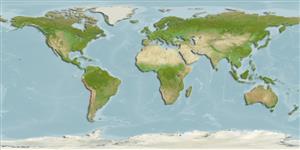>
Scombriformes (Mackerels) >
Scombridae (Mackerels, tunas, bonitos) > Scombrinae
Etymology: Sarda: Latin and Greek, sarda = sardine; name related to the island of Sardinia (Ref. 45335); chiliensis: Named after Chile, South America (Ref. 6885).
More on author: Cuvier.
Issue
Issue on validity of subspecies: subspecies considered as valid in FB, elevated to species rank as Sarda chiliensis (Cuvier, 1832) in Eschmeyer (CofF ver. May 2011: Ref. 86870).
Environment: milieu / climate zone / depth range / distribution range
पारिस्थितिकी
समुद्री; औशिनोड़िरोमस (Ref. 51243); गहराई सीमा 0 - 100 m. Subtropical; 60°N - 37°S, 149°W - 70°W (Ref. 168)
Southeast Pacific: northern Peru to Talcahuano, Chile (Ref. 9340). The northern subspecies Sarda chiliensis lineolata occurs from off the coast of Alaska, southward to Cabo San Lucas at the tip of Baja California, and in the Revillagigedo Islands.
Length at first maturity / आकार / वज़न / Age
Maturity: Lm 47.0 range ? - ? cm
Max length : 102 cm TL पुल्लिंग / अलिंग; (Ref. 9015); अधिकतम प्रकाशित वज़न: 11.3 kg (Ref. 168)
पृष्ठीय रीढ़ (सम्पूर्ण) : 17 - 19; ऐनल सौफट रेज़: 12 - 15; जानवरों की रीड़ का जोड़: 42 - 46. Mouth moderately large. Laminae of olfactory rosette 21 to 39. Interpelvic process small and bifid. Swim bladder absent. Spleen large and prominent in ventral view. Liver with elongate left and right lobes and a short middle lobe. Body completely covered with very small scales posterior to the corselet.
A coastal species that reaches sexual maturity at two years of age (Ref. 9340). Older individuals are encountered farther from the coast as compared to the juveniles (Ref. 9340). Spawning is discontinuous and a female of 3 kg may produce millions of eggs per season (Ref. 9340). Forms schools by size. Feeds on a variety of small schooling fishes, squids and shrimps. This species is important to the recreational hook and line fishery operating from private and party boats, piers and jetties, and from the shore. Also caught with encircling nets (Ref. 9340). Utilized fresh, canned and frozen; eaten broiled and baked (Ref. 9988).
Collette, B.B. and C.E. Nauen, 1983. FAO Species Catalogue. Vol. 2. Scombrids of the world. An annotated and illustrated catalogue of tunas, mackerels, bonitos and related species known to date. Rome: FAO. FAO Fish. Synop. 125(2):137 p. (Ref. 168)
IUCN Red List Status (Ref. 130435: Version 2024-1)
Threat to humans
Harmless
Human uses
मात्स्यिकी: उच्च वाणिज्य; आखेट मत्स्य: हां
साधन
Special reports
Download XML
इंटरनेट स्रोत
Estimates based on models
Preferred temperature (Ref.
123201): 14.6 - 23.1, mean 18.5 °C (based on 30 cells).
Phylogenetic diversity index (Ref.
82804): PD
50 = 0.5312 [Uniqueness, from 0.5 = low to 2.0 = high].
Bayesian length-weight: a=0.00955 (0.00838 - 0.01089), b=3.06 (3.02 - 3.10), in cm total length, based on LWR estimates for this species (Ref.
93245).
Trophic level (Ref.
69278): 4.5 ±0.3 se; based on diet studies.
Generation time: 7.1 ( na - na) years. Estimated as median ln(3)/K based on 2
growth studies.
लौटाव (Ref.
120179): माध्यम, न्यूनतम जनसंख्या दुगनी होने का समय 1.4 - 4.4 वर्ष। (K=0.15; tm=2).
Prior r = 0.51, 95% CL = 0.33 - 0.76, Based on 1 data-limited stock assessment.
Fishing Vulnerability (Ref.
59153): Moderate vulnerability (36 of 100).
Climate Vulnerability (Ref.
125649): High to very high vulnerability (71 of 100).
Nutrients (Ref.
124155): Calcium = 43 [25, 69] mg/100g; Iron = 2.8 [1.6, 4.8] mg/100g; Protein = 20.9 [19.8, 22.0] %; Omega3 = 0.363 [0.167, 0.758] g/100g; Selenium = 30.3 [17.5, 50.6] μg/100g; VitaminA = 12.1 [4.4, 36.7] μg/100g; Zinc = 0.427 [0.325, 0.634] mg/100g (wet weight);
